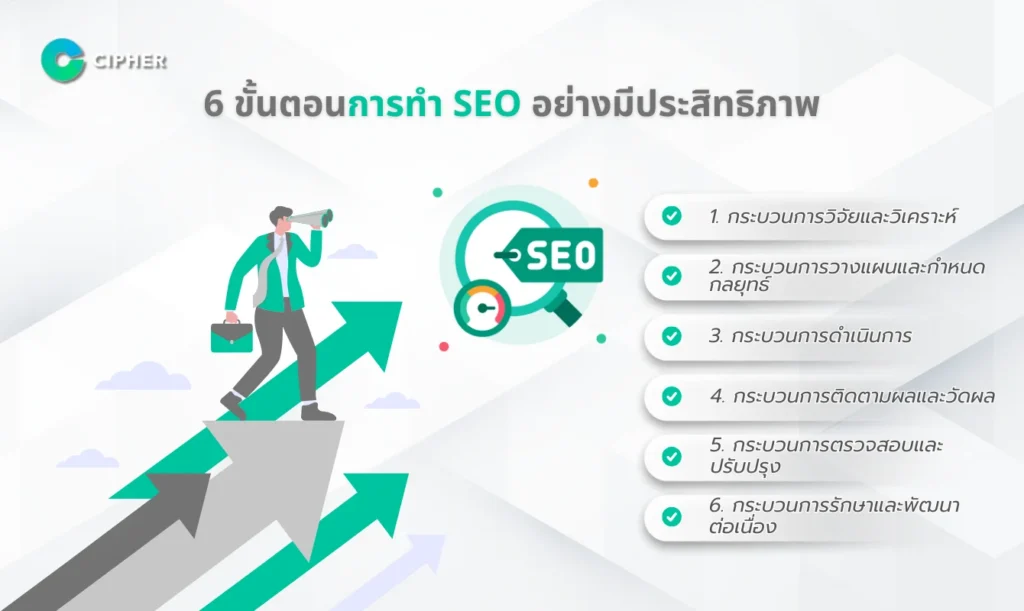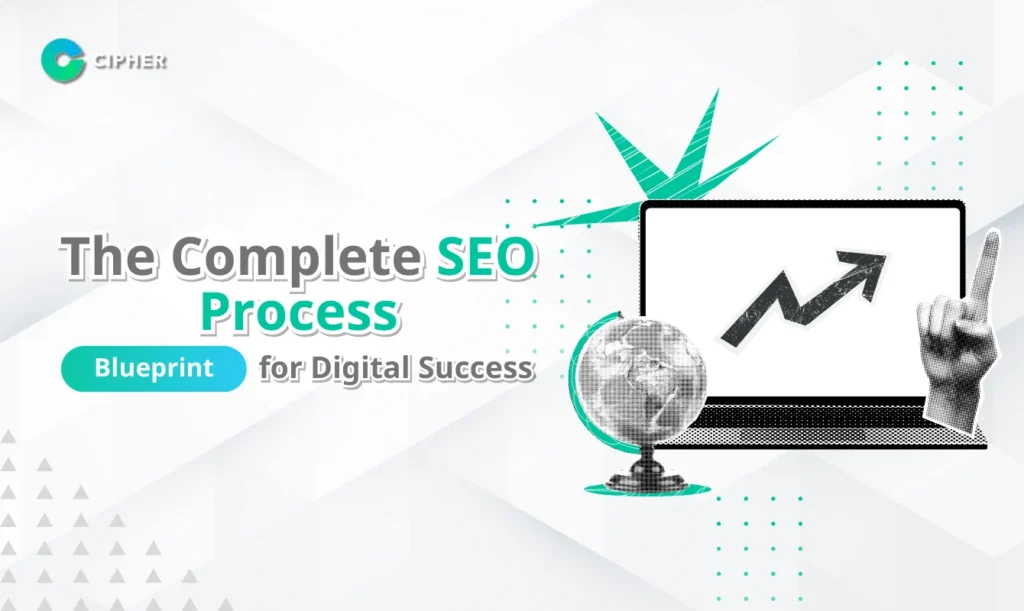If you’re looking for ways to make your website rank on Google’s first page, understanding the SEO process thoroughly is the key to your success. Many people may not fully understand what an effective SEO process should look like or how SEO works in practice. This article will dive deep into a systematic approach to search engine optimization design so you can effectively implement it on your website and achieve sustainable results.
Table of Contents
SEO is... What? What is SEO? Why is it Important for Online Business?

SEO is what businesses need to thrive in today’s digital landscape. It’s the process of optimizing your website to appeal to both users and Google. SEO optimization, which stands for Search Engine Optimization, simply means making your website suitable for search engines. In practical terms, it’s about making your website rank high in search results without paying for advertisements through strategic SEO optimisation techniques.
In an era where most people start their information search on search engines before making purchase decisions, knowing how to make search engines favor your website has become an indispensable marketing strategy because it helps:
- Reach customers when they need your products or services
- Save costs in the long run compared to buying advertisements
- Build credibility for your brand (people tend to trust organic search results more than ads)
- Work for you 24 hours a day, even while you sleep
Statistics show that 95% of internet users click on websites that appear on the first page of Google, with 32% clicking on the first ranking site, 16% on the second, and 10% on the third, and so on. Websites on the second page receive only about 1% of clicks. This demonstrates the critical importance of ranking high through effective SEO.
The 4 Pillars of Basic SEO Design
Before diving deep into the SEO process, we should understand that basic SEO design consists of 4 main pillars that form the foundation of any successful search engine optimization strategy:
1. On-Page SEO: Optimizing content and elements on your website, such as using keywords in appropriate positions, structuring content, writing compelling title tags and meta descriptions. Tools like Yoast SEO can help implement these best practices.
2. Off-Page SEO: Building credibility for your website from external sources, especially through quality backlinks or mentions from other reputable websites.
3. Technical SEO: Making technical adjustments to your website so Google can easily access and understand your content, such as implementing HTTPS, improving website speed, and ensuring mobile-friendliness. Core Web Vitals are now critical technical ranking factors.
4. Content Marketing: Creating quality content that meets user needs and aligns with the keywords you want to rank for.
6 Steps to an Effective SEO Process

1. Research and Analysis Process
- The first step in the SEO process is researching and analyzing relevant data, which is fundamental to understanding how SEO works for your specific industry. This includes:
- Be relevant to your business or website
- Have actual search volume at a satisfactory level
- Have high commercial intent, such as “how to do SEO to rank on the first page” or “SEO process price”
- Competitor Analysis: Examining what top-ranking websites for your target keywords look like, their content characteristics, website structure, strengths, and weaknesses.
- Search Intent Analysis: Understanding what users want when they search with specific keywords, such as seeking information, wanting to buy products, or comparing options.
2. Planning and Strategy Development
After gathering information from research, the next step in the SEO process is planning and setting strategies, which includes:
- Setting Clear Goals: Such as which keywords you want to improve rankings for, what percentage of traffic you want to increase, and within what timeframe.
- Planning Site Structure: Designing an organized website structure that is user-friendly and easy for Google to understand. A good structure should not be too complex (no more than 3-5 levels) for Google Bot to crawl efficiently.
- Keyword Mapping: Determining which page on your website should focus on which keywords to prevent internal competition.
- Content Planning: Deciding what type of content to create to address the keywords and search intent you want to rank for.
3. Implementation Process
This step involves executing the plan, covering all 4 pillars of SEO design and implementation:
On-Page SEO Implementation
- Create high-quality content that meets user needs
- Include keywords in important positions such as Title Tag, H1, URL, and content
- Write compelling meta descriptions that include relevant keywords
- Structure content for easy reading using headings (H1, H2, H3) appropriately
- Use images with properly named files and alt text
Off-Page SEO Implementation
- Build quality backlinks from reputable and relevant websites
- Create engagement on social media
- Do guest posting on related websites
- Create valuable content that people want to share and reference
Technical SEO Implementation
- Ensure Google can properly access and index your website
- Improve website loading speed
- Make your website mobile-friendly
- Install an SSL Certificate (HTTPS)
- Create XML Sitemap and Robots.txt
- Use Schema Markup to help Google better understand your content
Content Marketing Implementation
- Create valuable and useful content for your target audience
- Update content regularly
- Create diverse content formats such as articles, infographics, and videos
4. Monitoring and Measurement Process
SEO is not just about implementation but requires continuous monitoring and measurement to see if your strategies are working and what needs improvement:
- Track keyword rankings to see where your website ranks for your target keywords
- Analyze organic search traffic to see how many people visit your website through Google searches
- Monitor click-through rates (CTR) – the percentage of people who see your website in search results and click on it
- Analyze user behavior such as time spent on your website, bounce rate, and number of pages visited per user
- Track conversions such as registrations, purchases, and inquiries
5. Review and Improvement Process
After measurement, the next step is to analyze what works well, what needs improvement, and use that information to adjust your SEO strategy:
- Compare results with goals to see if they meet your expectations
- Analyze strengths and weaknesses to see which pages and keywords perform well and which don’t
- Test and improve by using data to experiment with strategy changes, such as adjusting title tags, adding content, or restructuring your website
6. Maintenance and Continuous Development Process
SEO never ends because Google constantly updates its algorithms, and competitors are always improving their websites. Therefore, you must:
- Monitor Google algorithm changes to adjust strategies accordingly
- Update content regularly to keep it current and useful
- Add new backlinks to maintain and increase website credibility
- Experiment with new techniques to continuously improve website performance
The Difference Between SEO and SEM
When talking about increasing visibility on Google’s pages, there’s another term we often hear: SEM (Search Engine Marketing), which differs from SEO as follows:
| Comparison | SEO | SEM |
|---|---|---|
| Cost | Requires effort and resources but no cost per click | Costs per click (Pay-per-click) |
| Results | Takes time to see results (3-6 months on average) | Immediate results after launching an ad campaign |
| Sustainability | Sustainable; once ranked, continues to generate traffic | Disappears from rankings immediately when budget runs out |
| Credibility | More trusted by users | May be viewed as advertising, resulting in fewer clicks |
Common Misconceptions About SEO
Although SEO has been a long-standing strategy, there are still misconceptions that many people hold onto, which may cause wasted time and resources:
“SEO is about writing long articles” Truth: Length isn’t as important as content quality. Short articles that address user needs well may rank better than long, rambling articles.
“Stuffing lots of keywords will help you rank” Truth: Excessive keyword stuffing can get your website penalized by Google. Keywords should be used naturally and be relevant to the content.
“SEO is a one-time task” Truth: The SEO process is continuous work because Google constantly updates its algorithms, and competitors are always improving their websites.
“Beautiful websites have good SEO” Truth: Beautiful websites that load slowly and have poor structure don’t help rankings. Good technical foundations and content are essential. Effective SEO design balances aesthetics with technical optimization.
“Buying lots of backlinks will help you rank quickly” Truth: Google can detect unnatural backlinks and may penalize websites that use this method. Focus on quality backlinks relevant to your business.
The Future of SEO in the AI Era
The arrival of AI technology is changing how people search for and consume information, which impacts how to do SEO to rank in the future:
- Google places more importance on “Authority.” Highly credible websites will have an advantage in rankings.
- AI Search is growing rapidly. AI-powered search systems like Google AI Overview, ChatGPT, and Bing Copilot are transforming how people access information.
- Content must be easy to understand and have a clear structure so AI can accurately extract and display information.
- Branding becomes more important. Brands that people know and frequently search for will have an advantage in rankings.
In the AI era, the SEO process isn’t just about making Google like your content but also “making AI like it” by focusing on content quality, credibility, and establishing an online presence.
Cipher's SEO Optimisation Services
As your digital marketing partner, Cipher is ready to help your business achieve its goals with comprehensive SEO optimisation services:
1. In-depth Website Structure Analysis
2. Keyword Research and Content Planning
3. Technical Website Optimization for Top Rankings
4. Building a Quality Backlink Network
5. Detailed Monitoring and Reporting
6. Local SEO for Community Businesses
7. Elevate Online Stores with E-Commerce SEO
Conclusion
An effective SEO process requires systematic work in 4 main areas: On-Page, Off-Page, Technical SEO, and Content Marketing, through 6 important steps from research, planning, implementation, monitoring, review, and continuous development. Understanding how SEO works is crucial for implementing strategies that yield results. Although results aren’t immediate, if done correctly and consistently, SEO optimization will become a digital asset that helps increase business opportunities in the long run. Proper SEO design integrates with your web development from the beginning, ensuring both users and search engines can effectively engage with your content. Cipher is ready to be your partner in helping your website rank on Google’s first page with a team of experts and years of accumulated experience in search engine optimization.





